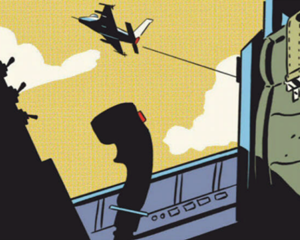Eventually, DARPA plans to pit teams of two planes against each other, each team being controlled jointly by a human and an AI. Many air forces hope that, one day, a single human pilot might even orchestrate, though not micromanage, a whole fleet of accompanying unmanned planes.
最終,DARPA計劃讓兩架飛機組成的團隊相互競爭,每個團隊由一個人類和一個人工智能共同控制。許多空軍希望未來可以由一名人類飛行員可以指揮整個隨行的無人機編隊,而不僅僅是對其進行微管理。
For this to work, the interaction between human and machine will need to be seamless. Here, as Suzy Broadbent, a human-factors psychologist at BAE, observes, the video-game and digital-health industries both have contributions to make. Under her direction, Tempest's engineers are working on "adaptive autonomy", in which sensors measure a pilot's sweat, heart-rate, brain activity and eye movement in order to judge whether he or she is getting overwhelmed and needs help. This approach has been tested in light aircraft, and further tests will be conducted next year in Typhoons, fighter jets made by a European consortium that includes BAE.
要做到這一點,需要人與機器之間進行無縫交互。正如BAE的人為因素心理學家蘇西·布羅德本特所觀察到的那樣,電子游戲和數字健康產業都可以助其一臂之力。在她的指導下,Tempest的工程師們正在研究“適應性自主”,用傳感器測量飛行員的汗量、心率、大腦活動和眼球運動,以此來判斷他或她是否力不能及、需要幫助。這種方法已經在輕型飛機上進行了測試,明年還將在由包括BAE在內的一家歐洲財團制造的“臺風”戰斗機上進行進一步測試。
Ms Broadbent's team is also experimenting with novel ways to deliver information to a pilot, from a Twitter-like feed to an anthropomorphic avatar. "People think the avatar option might be a bit ridiculous," says Ms Broadbent, who raises the spectre of Clippy, a famously irritating talking paper clip that harangued users of Microsoft Office in the 1990s and 2000s. "Actually, think about the information we get from each other's faces. Could a calming voice or smiling face help?"
布羅德本特女士的團隊也在嘗試用新方式向飛行員提供信息,從類似推特的進料裝置到人形化身。“人們覺得化身這個選擇可能有點荒謬,”布羅德本特女士說,她提出了Clippy的幽靈,即一種著名的會說話的回形針,曾于20世紀90年代和21世紀初對微軟辦公軟件的用戶‘高談闊論’。“實際上,想想我們從彼此的臉上得到的信息。一個平靜的聲音或者一個微笑的臉會有幫助嗎?”

Getting humans to trust machines is not a formality. Mr Colosimo points to the example of an automated weather-information service introduced on aircraft 25 years ago. "There was some resistance from the test pilots in terms of whether they could actually trust that information, as opposed to radioing through to air traffic control and speaking to a human." Surrendering greater control requires breaking down such psychological barriers.
讓人們信任機器并不是一種形式。科洛西莫舉了25年前在飛機上引入自動天氣信息服務的例子。“試飛員們對于他們是否真的能相信這些信息存在一些阻力,而不是通過無線電與空中交通管制人員通話。”放棄更大的控制權需要打破這種心理障礙。
One of the aims of AlphaDogfight, says Mr DeMay, was to do just that by bringing pilots together with airesearchers, and letting them interact. Unsurprisingly, more grizzled stick-jockeys tend to be set in their ways. "The older pilots who grew up controlling the radar angle…see this sort of technology as a threat," says Colonel Javorsek. "The younger generation, the digital natives that are coming up through the pipeline…trust these autonomous systems." That is good news for DARPA; perhaps less so for Colonel Javorsek. "These things that I'm doing can be rather hazardous to one's personal career", the 43-yearold officer observes, "given that the people who make decisions on what happens to me are not the 25-year-old ones. They tend to be the 50-year-old ones."
德邁先生說,“阿爾法狗之戰”的目標之一就是通過將飛行員和人工智能研究人員聚在一起進行互動來實現這一點。不出所料,更多頭發花白的棍騎師(老飛行員)傾向于堅持自己的方式。賈沃塞克上校說:“那些從小就能控制雷達角度的老飛行員……把這種技術視為一種威脅。更年輕的一代,通過管道涌現出來的數字原生代……信任這些自主系統。”這對DARPA來說是個好消息,但對賈沃塞克上校來說可能不是。這位43歲的軍官表示:“我所做的這些事情可能會對一個人的個人事業造成相當大的危害,因為決定我的遭遇的不是25歲的人,往往是50歲的人。”
譯文由可可原創,僅供學習交流使用,未經許可請勿轉載。











